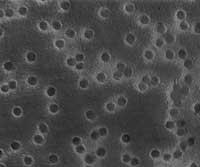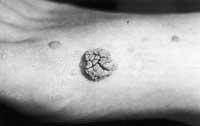Warts Warts

Verrites are one of the most frequent dermatological problems and it can be said that almost no one is free to have a verrite at some point in his life. There are more than thirty different varitas, each of them produced by a different type of virus, all of them specific to the human being. Animals have their own verrites, but cannot infect animals or vice versa.
And what is the reason why this dermatological problem increases like this? Extreme ease of contagion through small skin wounds. But there is no reason to worry. Almost all warts are benign, although a small percentage can become cancer. But they are always cancer or noninvasive cancers that can be cured.
After infection of the skin by the virus, infected cells reproduce very quickly. They accumulate in a given zone or moment and when they “fattened” or “fattened” that area is created a verrite. They can range between 2 and 2 cm. Of size and usually appear mainly in parts of the body at risk of infection: hands, feet, legs and face.
For its paleness, and for its aesthetic, so annoying, the “wisdom” of the people has proposed numerous remedies to eradicate warts, but none of them is scientifically demonstrable. It should not be forgotten, however, that verrites are originated by a virus, like the flu, and like it happens with it, without any treatment, in the end they are cured.
This was clearly demonstrated a few years ago when a group of dermatologists studied them applying a differentiated treatment to each of the four groups of people with warts. Some went to a healer, others were given a placebo (a substance that has no effect on treatment, although the patient does not know), those of the third group had no treatment and the fourth was medically treated. The results were very clear: the first three teams were cured at the same time; the fourth group was cured before.

This means that two out of three people with warts will lose without any treatment in a few years. In addition, of another remaining third, more than half will be cured spontaneously after a couple of years.
What can that person do, who by himself, without treatmentists, continues with the verrites? You can go to the doctor if due to its location the wart bothers you, or if for its size and place are not very aesthetic and therefore you want to eradicate.
There are many methods to remove warts, but some of them, such as the use of caustic substances, have hardly been proposed today. More widespread is the use of Duofil, a substance suitable for the skin, which after a treatment of one week to three weeks disappears. Another method is the use of liquid nitrogen, since the effects are faster. The nitrogen is applied on the viguilla, does not cause any damage, and by effect of the nitrogen an area is frozen, until the verrite is dried.
In the usual types of wart are:
- Common wart. Of flesh color, the skin is quite wrinkled and is the largest size. It may appear at any age, but it is mainly seen in childhood, especially in the hands. It does not produce pain and may disappear without treatment.
- Oinzola wart. They are round of rough skin and usually appear at the base and on the toes. The skin that covers the wart is very hard and can often be confused with the alley. They are sensitive to pressure and when the foot rests on the ground (that is to say when walking), pain appears. They may disappear in a few months, but usually do not disappear without proper medical or surgical treatment.
- Garatxo plane (plans). They are usually very small, smooth and meats. They usually appear in children or adolescents, mainly on the face, neck, wrist and knees. They usually appear in groups along the entire length of a crack or wound through which the virus entered. Many times they are mixed with peca or green. Although they may disappear spontaneously, this type of wart is very similar to treatment.
 They can vary between 2 and 2 cm. Of size and usually appear mainly in parts of body with risk of infection, that is, in hands, feet, legs and face.
They can vary between 2 and 2 cm. Of size and usually appear mainly in parts of body with risk of infection, that is, in hands, feet, legs and face. - Filiform warts, filiform. They are soft, thin warts with point and hard end. They usually appear on the face, neck, chin or eyelids, grouped alone or in group. If they are not touched, they usually disappear spontaneously, but because they appear in the places where they usually appear, especially by surgical removal.
- Anogenital warts or pointed papillomas. These special warts that appear in adults are like cauliflower, grow very fast and are usually captured by sex (although not always). They may disappear spontaneously, but it is also possible to reinfect and the safest way or way is to go to the doctor to evaluate the problem and the most appropriate treatment. A substance is usually placed on the wart, allowed to dry, and removed six hours later. This procedure is repeated every 10-15 days until the disappearance of the wart is achieved. In some cases it may be necessary to use other methods (surgical extraction, electrocoagulation or cryotherapy).
- Nail warts. They are seen in children and adolescents around the nails, also under the nails, on the fingers of the hands and feet. Treatment is usually a surgical extraction.
- Seborrheic herons. Unlike the remaining verrites, these “verrites” of old age are only accumulations of keratin due to the aging of the different skin structures; dark or black spots. Therefore, they have nothing to do with viruses. These benign tumors are not contagious but do not disappear spontaneously.






